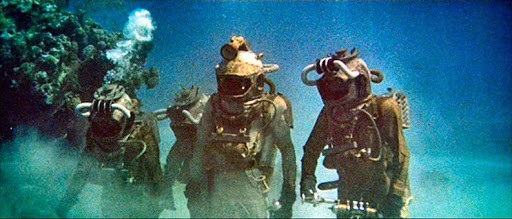
The concept of creating a camera that could go underwater wasn’t perfect back in the day, but it was still possible since the movie 20,000 Leagues Under the Sea was in fact filmed underwater, but in as controlled of a condition as could possibly be since apparently there was hemp laid on the seafloor to control the amount of sand that was kicked up from the movements of the actors and the crew. But there wasn’t much filming time since the scuba tanks of that time were severely limited and there were 20 minutes required to lower everyone into place and then take them back up, which left only 10 minutes of filming time for the allotted 50 minutes that they were given. In other words, it took a lot of effort and a lot of time to get the shots that were needed most times and as one should be able to imagine, there were plenty of safety precautions to think about since underwater pretty much anything could happen, unless the filming is being done in a tank where just about everything can be controlled to some degree. But yes, cameras have been going underwater for a while now, and despite their simple beginnings, the underwater cameras have evolved quite a bit in the last several decades as filming techniques have continued to improve.
Filming underwater isn’t that easy even now since there are a great number of variables that one might have to deal with if filming in open water, which doesn’t sound like the best idea since there are just too many things that can happen. Many movies have taken place in large tanks of water though where just about every variable can be measured and every safeguard is taken, but accidents have still happened on occasion. The process has come a long way though since the early days and filming underwater is a far more accurate process than it used to be since the equipment is updated, the safety of the actors and the crew is of the greatest importance, and when there’s something that can’t be produced in a practical manner, there’s CGI. Some people aren’t too fond of CGI effects when it comes to a movie that’s filmed underwater since they tend to come off looking pretty cheesy and not at all real. The thing about this however is that many of those that think that the effects look cheesy and unreal might never have set foot near the locations where said events are taking place, or might not have ever been near the creatures or environments that are being featured in the movie.
It’s true that filming underwater environments might be a bit tricky at times, but in the open water, it’s harder simply because there’s more to account for and less that can be controlled. In a closed and controlled environment, it’s far more possible, as the animals that are being used, especially if they’re real, are trained and have trainers on hand to help them with their cues and are typically kept as docile as possible. There are always bound to be challenges that will pop up from nowhere and there will always be new ways of doing something that might have been considered too complicated in years past, but filming underwater has been an evolving practice for some time now that has gone on for a while and has produced several impressive and very memorable scenes that people still enjoy recalling from time to time. The difference in the techniques and methods that can be seen from decades ago to now is simply amazing since obviously, the cameras back in the day weren’t nearly as advanced as those today, but they were still fully capable of creating an image that would go on to impress a great number of people. Does anyone remember watching 20,000 Leagues Under the Sea and just being blown away? Now think ahead to other underwater movies that have been even more impressive and try to think about what had to happen in order for this type of entertainment to evolve.
Underwater filming back in the day wasn’t perfect by any means, but it was impressive for its time since one might have thought that it would all be some effect that might be placed on the camera lends to make the actors appear as though they were underwater. After all, there were several practical ways of filming that came before this breakthrough, and many of them might have required a lot more imagination on the part of the audience, but at the same time, one can easily admit that they worked. A lot of the movies that we have today that are filmed underwater are just as controlled as they can be, but the effects that are used are often quite useful since it gives the audience what they want.
 Follow Us
Follow Us





